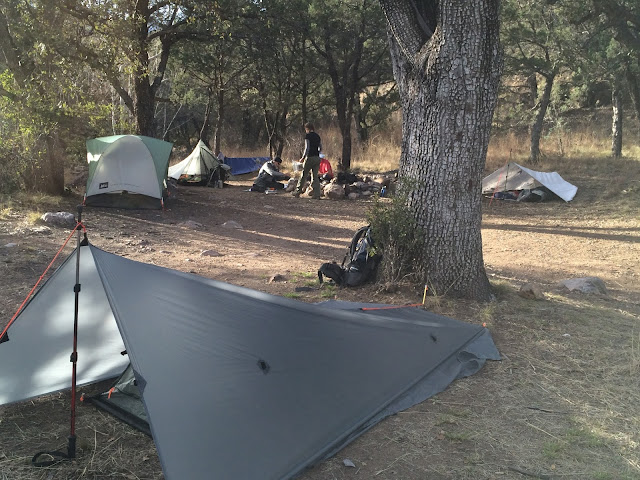In my previous post about my
first backpacking trip, I shared that I took a 3-person tent for shelter. Basically, it was a Target-brand version of the standard Coleman 3-person tent.
 |
| My 3-person tent, packed and loaded at the top of my backpack |
 |
| The same tent, (almost) set up |
Can you imagine carrying that thing for several miles over several days? Since that time, I've experimented with several shelter options in my quest to decrease weight and bulk for backpacking trips. I was also fortunate that Doc, my backpacking partner in Arizona, was on the same quest. It comes down to two basic types of shelters: tents and tarps.
Tents vary considerably in shape, weight, and amenities. In fact, that same 3-person tent I took on my first trip could be a decent option if split amongst multiple people, for instance with one person carrying the tent, a second carrying the poles, and the third carrying the fly and stakes. 3-person tents are really only meant for 3 people doing nothing but sleeping, however, so packs would have to stay outside. If divided among 2 people, packs could fit inside, but each person would (obviously) just have to carry more.
Three-season backpacking tents have also become very popular. Most are mummy-shaped to match your sleeping bag and pad and include a fly that reaches all the way to the ground to provide a covered area for your pack outside the tent-proper. Because they're engineered to maximize durability while minimizing weight, though, they tend to be quite expensive. Most run on the order of $200. That said, I found a great deal on the No Limits Kings Peak II 2-person backpacking tent at
Academy Sports a few years ago for $70 (pictured below; click
here to view online). I've been extremely happy with this one, but I use it as a one-person tent.
 |
| Academy's No Limits Kings Peak II, shown with the fly on and closed |
 |
| Shown with the fly and side door unzipped |
 |
| Shown packed alongside hammer to depict size (don't take the hammer backpacking! :) |
Backpacking tents still tend to be heavy. My Kings Peak II weighs in at 5+ pounds. Even if you're willing to pay more, the payoff in weight loss is usually no more than a little over a pound. To take off more weight and get a tent that weighs only 2-3 pounds, be prepared to shell out $300-$400.
Another option that is very popular among backpackers today is a tarp. They come in all shapes and configurations, but the flat tarp (in my opinion) is the best because it's the most versatile. The number of configurations you can set it up in is almost limitless (
SGT Rock's website gives several common configurations). Tarps are also light -- much lighter than tents in most cases! This is primarily because you only have the weight of the tarp material and guylines since any support needed can be provided by trekking poles, a stick you find around the campsite, or by tying the tarp off to trees. I have a Bear Paw Wilderness Designs 8x10 Sil-Nylon Flat Tarp, and it weighs less than a pound (not including stakes).
One potential drawback to tarps is that most tarp pitches leave at least one opening to the outside world (i.e., you're not completely enclosed). I haven't had a lot of exposure to camping in wet weather, but I'm told that if you pitch and orient your tarp correctly, you can stay just as warm and dry as you can in a tent. While I believe this to be largely correct, realize that you don't always have the luxury of those choices at your campsite, especially if you're camping with several people. Additionally, because in the desert I was afraid of a snake or scorpion snuggling up next to me in the middle of the night, I bought a bug net to go with my tarp. It's a fully enclosed "mini-tent" made out of bug net material, so it's very light. The tarp and the bug net together weigh about two pounds.
 |
| My tarp, shown with the bug net |
 |
| My tarp in the foreground. Doc's TarpTent is in the back left behind the REI 3-person tent |
While, just with most backpacking gear, you can cut weight and bulk with more money, tarps don't have to be expensive. On my second backpacking trip, I went with a group of scouts that preferred to sleep under the stars, so I took an 8x10 tarp just like you can buy at Wal-Mart or Lowe's. Unfortunately, it was raining. Lacking experience on tarp setup, I literally wrapped up in the tarp like a burrito. It wasn't pretty, but I stayed warm and dry.
If tents seem too heavy, but tarps seem just a little too primitive for you, some companies make hybrid products. They are as light as tarps, but they set up more like tents. My hiking partner, Doc, used a couple of different products, including the
TarpTent ProTrail. It really is the best of both worlds. (In the picture above, Doc's TarpTent is in the back left of the photo.) The only downsides are that it's a little expensive ($225) and, like tents, they're really one-trick ponies. In other words, you only get one type of pitch, so if you find a campsite that doesn't fit that optimally, you're stuck.
As an aside, many backpackers are now opting for hammocks both out of comfort and to minimize the environmental impact of covering the ground. I'm intrigued by this new trend but as yet have no experience with it. My initial research, however, shows that a backpacking hammock system weighs on the order of 3-4 pounds when accounting for an underquilt to provide warmth and a tarp and bug net to protect you from the elements. All that gear will also set you back $300-$500. Many that have tried it say the better night's sleep is well worth the trade-off, though.
Ultimately, the choice you make comes down to a few factors: First and foremost your comfort and expertise. If you can't imagine sleeping under a tarp open to the elements or aren't familiar with setting up a tarp, the extra weight of a tent might be worth it. Additionally, if I expected a strong chance of snow or rain, I might opt for the tent instead of the tarp so I didn't have to worry about the possibility of ruining a good night's sleep and possibly dealing with wet gear the next day. Practice and experience can mitigate many of those fears and inadequacies, though. Practice setting up the tarp in your backyard will make the setup go smoother. And experimenting on a night with bad weather has low risk as well since you can come inside at any time. Personally, I like the flexibility my tarp provides and the weight it saves. I would pack a tarp on 90-95% of the backpacking trips I go on, knowing I could be reasonably well protected on a night with unexpected wind and rain.






































